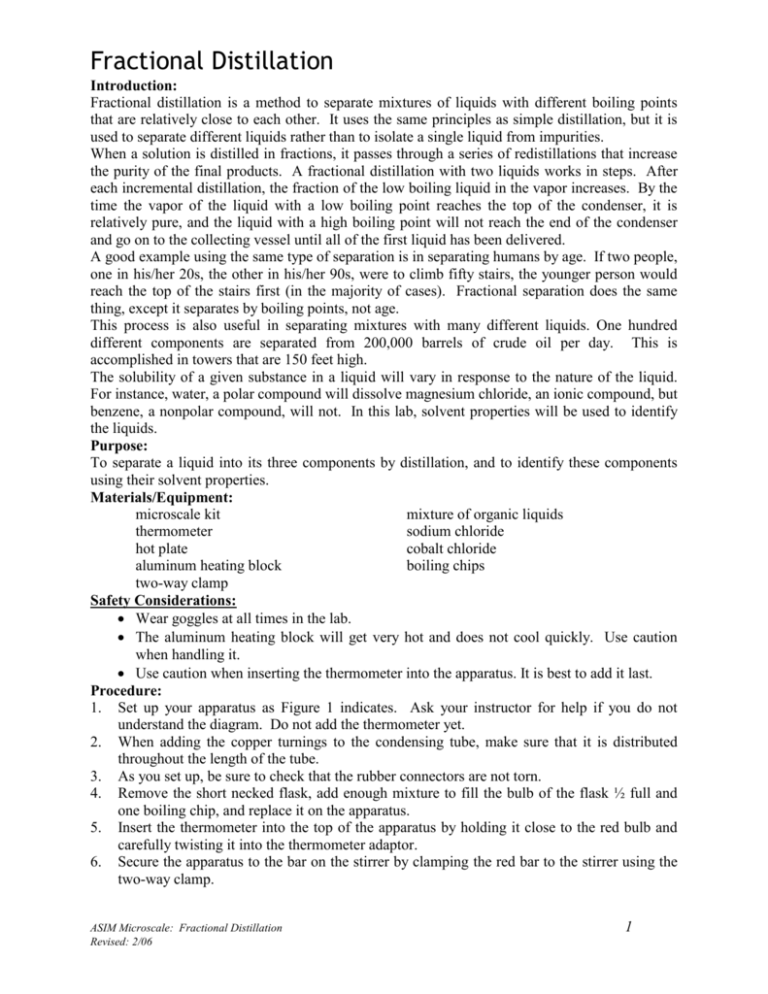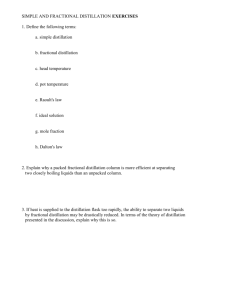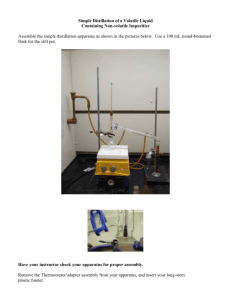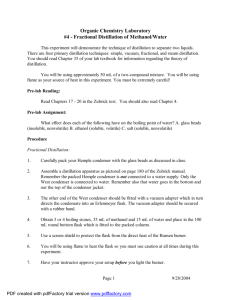Fractional Distillation
advertisement

Fractional Distillation Introduction: Fractional distillation is a method to separate mixtures of liquids with different boiling points that are relatively close to each other. It uses the same principles as simple distillation, but it is used to separate different liquids rather than to isolate a single liquid from impurities. When a solution is distilled in fractions, it passes through a series of redistillations that increase the purity of the final products. A fractional distillation with two liquids works in steps. After each incremental distillation, the fraction of the low boiling liquid in the vapor increases. By the time the vapor of the liquid with a low boiling point reaches the top of the condenser, it is relatively pure, and the liquid with a high boiling point will not reach the end of the condenser and go on to the collecting vessel until all of the first liquid has been delivered. A good example using the same type of separation is in separating humans by age. If two people, one in his/her 20s, the other in his/her 90s, were to climb fifty stairs, the younger person would reach the top of the stairs first (in the majority of cases). Fractional separation does the same thing, except it separates by boiling points, not age. This process is also useful in separating mixtures with many different liquids. One hundred different components are separated from 200,000 barrels of crude oil per day. This is accomplished in towers that are 150 feet high. The solubility of a given substance in a liquid will vary in response to the nature of the liquid. For instance, water, a polar compound will dissolve magnesium chloride, an ionic compound, but benzene, a nonpolar compound, will not. In this lab, solvent properties will be used to identify the liquids. Purpose: To separate a liquid into its three components by distillation, and to identify these components using their solvent properties. Materials/Equipment: microscale kit mixture of organic liquids thermometer sodium chloride hot plate cobalt chloride aluminum heating block boiling chips two-way clamp Safety Considerations: Wear goggles at all times in the lab. The aluminum heating block will get very hot and does not cool quickly. Use caution when handling it. Use caution when inserting the thermometer into the apparatus. It is best to add it last. Procedure: 1. Set up your apparatus as Figure 1 indicates. Ask your instructor for help if you do not understand the diagram. Do not add the thermometer yet. 2. When adding the copper turnings to the condensing tube, make sure that it is distributed throughout the length of the tube. 3. As you set up, be sure to check that the rubber connectors are not torn. 4. Remove the short necked flask, add enough mixture to fill the bulb of the flask ½ full and one boiling chip, and replace it on the apparatus. 5. Insert the thermometer into the top of the apparatus by holding it close to the red bulb and carefully twisting it into the thermometer adaptor. 6. Secure the apparatus to the bar on the stirrer by clamping the red bar to the stirrer using the two-way clamp. ASIM Microscale: Fractional Distillation Revised: 2/06 1 7. Lower the apparatus so that the short necked flask rests in the largest hole on the aluminum heating block. 8. Set the stirring motor on 2 or 3 then turn the heat to a power setting of 5 to begin heating your mixture. Heat slowly. 9. As the mixture begins to boil, note the condensation of the vapor as it rises in steps through the copper turnings. 10. The temperature will increase rapidly until the vapor condenses on the bulb of the thermometer. At this point (between 55C and 60C) the temperature will remain fairly constant. This temperature is the boiling point of that first component. 11. Collect the liquid that drips from the distillation arm into the Erlenmeyer flask. The temperature should remain constant until all of that component has boiled out of the mixture. 12. Next, the temperature will slowly increase. When the temperature exceeds 62C, carefully remove the flask, label it "A," and collect the second fraction in another flask. Again the temperature should remain constant while this liquid boils. 13. The temperature will begin to rise again after the second fraction is collected. When the temperature exceeds 90C, carefully remove the flask, label it "B”.. 14. The fraction remaining in the round-bottomed flask is "C." 15. DO NOT LET THE FLASK RUN DRY! 16. Carefully remove the thermometer and let the apparatus cool as the next few steps are performed. 17. Obtain a few crystals of both sodium chloride and cobalt chloride on separate pieces of folded paper. 18. Place one crystal of sodium chloride into each container. Stir or agitate vigorously. Fill out the data table with “soluble” or “insoluble,” and note any color changes. 19. Repeat step 18 with cobalt chloride instead of sodium chloride. 20. Carefully disassemble the apparatus and place in the appropriate places in the kit. Reference Table Methanol Acetone Water Sodium Chloride insoluble insoluble soluble Cobalt Chloride soluble, pink/purple soluble, blue soluble, pink Compare the observations below with the Reference Table to identify the liquids. Data/Conclusions: A B C Observed b. p. Sodium Chloride Cobalt Chloride Identity of Fraction Questions: 1. How were you able to determine the identities of the fractions? 2. If you tried this experiment without using copper in the fractionating tower, would your results have been different? Why or why not? 3. Is boiling a physical or chemical change? Explain. 5. Is the boiling point of a substance a physical or chemical property? An intensive or an extensive property? Explain. 6. The accepted boiling points for acetone, methanol, and water are 56C, 65C, and 100C, respectively. How close did you come to the actual boiling points of the three compounds? 7. Nitrogen and oxygen are ranked second and third of the top 25 chemicals in the U. S. Explain how fractional distillation may be used to obtain these gases from an air sample. (Refer back to Chapter 1) ASIM Microscale: Fractional Distillation Revised: 2/06 2






